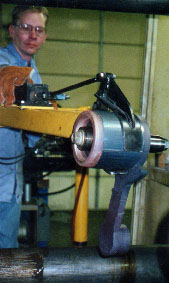February 28, 2001
FOR IMMEDIATE RELEASE
NEW YORK - Motors using new, die-cast copper rotors reduce electric energy losses by 15-23 percent, compared with motors using identical aluminum rotors, the current industry standard, according to Dr. John Cowie, vice president for sheet, strip and plate for the Copper Development Association. He said pre-production runs of motors using the innovative copper rotors show 1.2-1.7 percent improved energy efficiency, depending on the rotor design, and exceed the potential indicated in earlier pilot runs.
 Several major motor manufacturers undertook the effort in conjunction with a CDA-managed research and development program begun three years ago, funded in part by the U.S. Department of Energy, the Air Conditioning and Refrigeration Technical Institute and the International Copper Association.
Several major motor manufacturers undertook the effort in conjunction with a CDA-managed research and development program begun three years ago, funded in part by the U.S. Department of Energy, the Air Conditioning and Refrigeration Technical Institute and the International Copper Association.
"Adoption of this process by motor manufacturers for integral horsepower motors," Cowie said, "can mean an extraordinary reduction in electrical energy generating requirements worldwide, significant savings on electrical energy costs, and an increased lifespan for electric motors."
Cowie said use of the copper rotor reduced motor operating temperatures by 5 degrees C to 32 degrees C. As a general rule, for every 10-degree increase in the motor operating temperature, the insulation life of the motor is cut in half. "Therefore," Cowie points out, ?these data indicate the life of motors using copper rotors may be extended 50% or more, with proper maintenance.
The improvement in motor efficiency was demonstrated to be consistent, irrespective of such variables introduced into the die-casting process as pressure, shot speed and cooling rate. "Consequently," Cowie says, "from these data, it appears that the process of die-casting copper rotors can be quite reliable and robust. Six different sizes and types of rotors were die-cast using pure, high-conductivity copper for motor companies worldwide by Formcast in Denver, Colorado.
Electrical efficiency tests were performed on an assortment of motors using these copper rotors in accordance with IEEE Specification 112, Test Method B, as required by the National Electrical Manufacturers Association (NEMA). The results from these tests exceeded CDA expectations, according to Cowie. He said further improvements in process and rotor design such as optimization of the steel laminations, should extend copper's lead in efficiency over that for aluminum. CDA will conduct additional evaluations with major manufacturers throughout this year to fully develop and transfer the technology for their production motors.
###
